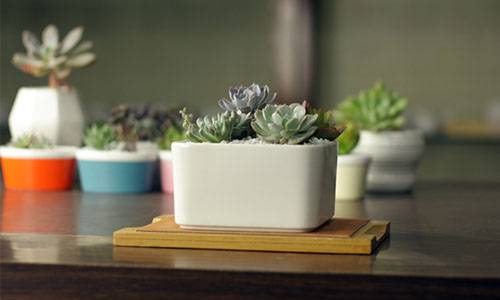

The fundamental difference between ceramics & pottery, not in the firing temperature of high and low, not in the size of the water absorption rate, not in the glaze of the presence or absence of water, but in the tire quality of the difference – pottery tires by low silicon low aluminum high iron secondary clay composition, porcelain tires by high silicon high aluminum low iron (such as celadon, white porcelain, blue and white porcelain, celadon) or high silicon high aluminum high iron (such as black tires, brick red tires, purple tires or light brown tires of Jian Kiln, Xiba kiln porcelain) of the porcelain clay composition;
Low-silicon, low-aluminum, high-iron clay composition of the tire can not withstand high temperatures above 1000 ℃, and therefore can not reach the degree of sintering and high water absorption; high-silicon, high-aluminum, low-iron or high-silicon, high-aluminum, high-iron clay can withstand high temperatures above 1200 ℃, and therefore can reach the degree of sintering and low water absorption.
Lead-glazed pottery refers to pottery made of low-silica, low-alumina, high-iron secondary clay, with copper, iron, cobalt, and other metals as colorants, lead as a co-solvent, and calcium, potassium, sodium, and other alkali metal glazes, and fired in the kiln at a temperature of less than 1,000°C.
The so-called lead glaze porcelain, is high silicon, high alumina, and low iron porcelain clay composition of the porcelain, into the kiln at a temperature of more than 1000 ℃ fired plain, and then applied to copper, iron, cobalt, and other metals as coloring agents, lead as a co-solvent, as well as calcium, potassium, sodium and other alkali metal synthesis of glaze, into the kiln at a temperature of less than 1000 ℃ in the second firing of the object.
Or is this porcelain lead glaze blank in the kiln temperature below 1000 ℃ in a one-time firing out (raw firing) objects. Pottery and porcelain differences.
1. pottery (plain pottery, clay glaze pottery, lead glaze pottery) is made of low-silicon, low-aluminum, high-iron secondary clay billet (glazed or unglazed) dried into the kiln at a temperature of 1000 ℃ below the one-time firing of the object.
2. Vegetal porcelain (traditionally called “white pottery” and “hard pottery with seal script”) is made of high-silicon, high-aluminum, low-iron or high-silicon, high-aluminum, high-iron porcelain clay, dried, and then fired in the kiln at a temperature of 1,000°C or less in a single firing.
3. Calcium glazed porcelain is made of high silicon high alumina low iron or high silicon high alumina high iron porcelain clay, billet, applied (calcium) glaze, dried, into the kiln at a temperature of 1000 ℃ or more in a one-time firing.
4. Lead-glazed porcelain, is a high silicon high alumina low iron porcelain clay composed of porcelain tires, into the kiln at more than 1000 ℃ temperature first fired into plain porcelain, and then applied to copper, iron, cobalt, and other metals as coloring agents, lead as a co-solvent, and calcium, potassium, sodium, and other alkali metals synthesized lead glaze, and then into the kiln at a temperature of less than 1000 ℃ refired; or is this porcelain tires lead glaze blank in the kiln temperature of less than 1000 ℃ one-time Fired out (raw firing) ware.
5. glaze pottery glaze “clay glaze” and “lead glaze” two kinds, is low-temperature glaze; calcium glaze porcelain glaze for lime alkali glaze, is a high-temperature glaze.
6. pottery because of its low silicon low aluminum high iron secondary clay tire and can not withstand more than 1000 ℃ high temperature and can not make the tire body sintering, so the water absorption rate is high; calcium glaze porcelain because of its high silicon high aluminum low iron or high silicon high aluminum high iron porcelain tire and can withstand more than 1000 ℃ high temperature so that the tire body sintering, so the water absorption rate is low.
7. The production of pottery, from archaeological excavations, in China has a history of nearly 10,000 years, while calcium glazed porcelain, only 3,000 years of history (evidence for the original porcelain divorce fragments unearthed at the Erlitou site).
CERAMICS & POTTERY OF THE SAME POINT:
In its process is the same, that is, there is a selection of soil (clay, porcelain clay), practice clay (clay, porcelain clay), billet (pottery billet, porcelain billet), glaze (vegetal pottery, except porcelain), drying, kiln firing – high-temperature tire lead glaze porcelain there is a second kiln re-firing process.
We distinguish the many differences between pottery and porcelain, the most essential characteristics of the only difference in the quality of the tire, is the most fundamental.
Therefore, firing temperature can not be used as the essential factor to distinguish between pottery and porcelain. Because the pottery has high-temperature pottery (close to 1000 ℃) also has low-temperature pottery (600 ℃ or so); porcelain, there are high-temperature porcelain (such as blue) and low-temperature porcelain (such as “white pottery” – the main reason for the low firing temperature is that prehistoric firing technology can not make the kiln temperature to 1000 ℃ or more) of the difference.
RunSun Houseware design
As a global leader in Houseware, RunSun provides more than 2500 Houseware designs for Europe, America, and Australia.
Contact RunSun
Email: [email protected]
WeChat/Whatsapp: (+86)13246751686
Phone: +86 13246751686
Website:https://www.runsun-trans.com/

